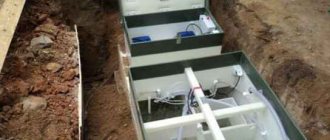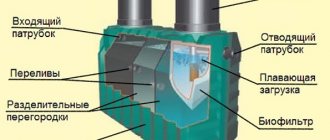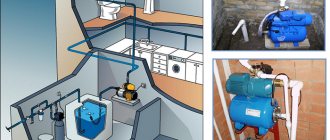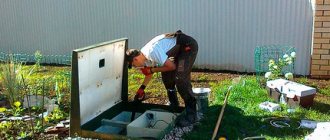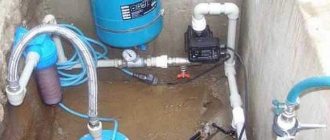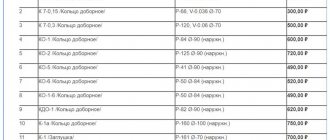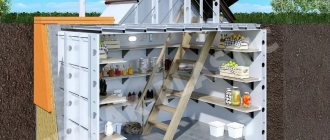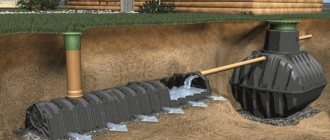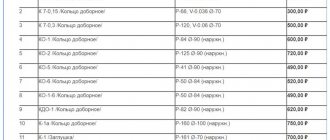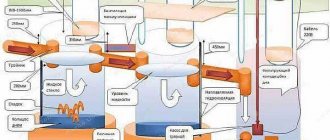Septic tank design features
Design of a septic tank model Topas
The Topas treatment system is a monoblock structure designed for any type of soil. It has a polypropylene body.
The main difference is the method of wastewater treatment; in a Topas septic tank this occurs thanks to anaerobic bacteria, the life of which requires oxygen. The use of such a sewer does not require maintenance.
Unlike other similar devices, its maintenance involves periodically checking for proper operation. But it is worth remembering that at one time you can drain the volume of water not exceeding that indicated in the passport.
Autonomous sewerage using a Topas septic tank can be used in any climatic zone; its operating scheme does not depend on temperature and other indicators. Installation of equipment for a private home does not require concreting the site for it. When installing, you can limit yourself to a sand cushion.
Topas 5
The compact dimensions of the septic tank allow it to fit in a pit measuring 1.5x1.5 m. Wastewater treatment with Topas brand equipment reaches 98% and the output complies with existing standards.
The design of the Topas septic tank involves an absolutely sealed body made of material that is resistant to aggressive environments, which makes its use environmentally friendly. In addition, during its operation you will not have to call a sewage disposal truck. Maintenance consists of pumping sludge out of the system, no more than once a quarter. Moreover, it can be used as fertilizer in the garden.
Advantages and disadvantages of the Topas septic tank
The advantages of the Topas septic tank are as follows:
- Processing of all types of household waste;
- Easy installation of a septic tank without concreting the base;
- No need to frequently call vacuum cleaners;
- Minimum occupied space on the site for “Topas”;
- High degree of purification of 97–98%;
- No unpleasant aroma;
- Possibility of year-round use;
- Possibility of installing sewerage even in winter.
Space on the site near the house for a Topas septic tank, designed for 3-4 people, requires about 1-2 square meters. He doesn’t need to call a sewer truck. A couple of times a year, sludge needs to be pumped out of this treatment plant. But you can do this yourself. At the same time, the sludge mass obtained as a result of the operation of the septic tank, after composting, turns into an excellent fertilizer, ideal for garden beds.
Among the disadvantages of operating a Topas septic tank, the following should be mentioned:
- The need for regular maintenance of compressors;
- Restrictions on salvo discharge;
- Dependence on electricity supply.
Each Topas VOC model has its own limitation on the one-time flow of wastewater. The first chamber is designed only for a strictly defined volume of water. If more sewage is released into the house sewer in two hours, then this compartment simply will not be able to handle it.
If there is a long power outage, problems may even begin. The operating principle of these septic tanks is based on constantly turning on/off pumps to pump wastewater from one chamber to another and supply oxygen to aerobic bacteria. If there is no electricity for more than a day, the degree of purification will drop and the outlet water will become cloudy.
Device installation
Now let's talk about how to install a Topas septic tank. There is nothing complicated about this and you can do everything yourself. The only thing is that you will have to invite helpers when lowering the device into the pit.
Installation of a Topas septic tank begins with determining a suitable location. Here you need to take into account the following facts:
- The place should be located close to home. According to the attached instructions, the minimum distance from the installation site of the Topas septic tank to the main building is five meters.
- When choosing a location, try to ensure that the sewer pipes leaving the house go straight to the septic tank. Excessive bends and turns can contribute to the formation of blockages, which means additional cleaning work.
- There should be no thick vegetation around the installation site. The roots of trees and large bushes can damage the body of the septic tank.
- It is also worth finding out the depth of soil freezing in your region. This will determine how far from the surface sewer pipes and the cleaning device itself can be laid.
- If groundwater is close to the surface, then the bottom of the pit must be reinforced with a concrete slab or sand-cement screed.
If we have decided on the location, then we start digging a pit. Its dimensions will depend on the selected Topas septic tank model. As a rule, such devices are relatively compact, so digging a pit can be done manually.
When carrying out excavation work, we must not forget about the necessary gaps between the walls of the pit and the body of the septic tank. They are needed for further backfilling of the device with soil. Such gaps should be at least 20 cm. Also, the depth of the pit should be made greater in order to install a sand cushion. If groundwater comes close to the surface, then the depth is determined taking into account the installation of a concrete slab or sand-cement screed.
After the foundation pit is ready, its foundation is made. The sand cushion should be at least 15 cm. Also try to make sure that the upper part of the septic tank protrudes above the ground. This is necessary to prevent spring melt water from flooding the device’s equipment.
After equipping the base, lower the septic tank into the pit. This can be done manually with the assistance of an assistant. To do this, use cables threaded through special holes in the structural ribs.
The next step will be connecting the septic tank to communications. The first step is to connect the sewer pipe. It is first necessary to dig trenches for the pipes and lay the pipeline itself.
When laying sewer pipes, do not forget about the slope. It should go from the house to the septic tank and be 1-2 cm per linear meter. The depth of laying pipes will depend on the depth of soil freezing. As a rule, it is from 70 to 80 cm.
Before starting connection work, the septic tank must be leveled using a building level. Only in a strictly horizontal position will the device work more efficiently.
To connect the sewer pipe to the septic tank, a hole of the required diameter is made in the body. Everything must be done according to the attached instructions. Then a pipe is welded to the hole; it is advisable to do this using a polypropylene cord and a hair dryer. After the connection has cooled, a sewer pipe is inserted into the pipe.
Now it’s time to connect the electrical cable. It must be carried out from the panel in the house with a connection to a separate machine. The cable itself is laid in a corrugated pipe and can be placed in the same trench as the sewer pipes. Electricity is connected to a special hole with marks on the body of the septic tank.
After connecting the power supply and sewerage pipes, the septic tank is filled with soil. This must be done gradually, in layers of 15–20 cm. At the same time, water is poured into the container to equalize the pressure. The water level should be slightly above the backfill level. So, gradually, layer by layer, the septic tank is completely covered with soil.
If the level of soil freezing is quite high, you can insulate the septic tank. This is done before filling with soil. Any heat-insulating material intended for laying in the ground can be used as insulation.
This completes the installation of the Topas septic tank. If everything is done correctly and taking into account the recommendations set out in the instructions for the product, the device will last for decades.
Preparation for installation
Topas brand devices are models of autonomous sewage systems, in which the full cycle of wastewater treatment occurs inside the structure. It is allowed to install a Topas septic tank in a country house or in a house where the owners either live permanently or visit periodically. The peculiarity of the design is that waste water is constantly required for its operation. After all, for bacteria living in a bioreactor, biological waste is the main food; without it, living organisms simply will not survive and work will be completely disrupted.
Before installing Topas septic tanks, you should consider the type of soil. Models with a gravity drainage type are installed only in loose soil, where the main components are black soil and sand. For clayey and rocky soils, the use of models with gravity flow is impractical, because water simply will not drain into dense soil. Therefore, in such soils, devices with forced water drainage are used. The main feature of such septic tanks is the presence of a drainage pump and a special compartment for collecting the resulting liquid. This water can be reused for household needs, which is very convenient and economical.
Options for organizing wastewater disposal
By gravity into the drainage well
By gravity into the storage tank
Into the intermediate well
With a UV block in a pond
The choice of location for installing a Topas septic tank should be approached very carefully. The position of the station is determined in compliance with sanitary standards. First of all, customers should contact the SES and obtain permission for installation on site, since the product is potentially dangerous and can cause damage to the environment.
The corresponding design document is submitted to the SES, according to which the possibility of installing the product on the site and compliance with all rules and regulations is assessed. So, the structure is installed at a distance of at least 50 meters. It is allowed to install a Topas septic tank at a distance of at least 30 meters from any open water source, for example, a river, lake or reservoir. The station must be located away from trees and bushes at a distance of at least 3 meters, and the distance from the foundation of the house to the product must be at least 50 meters.
Operation of a septic tank
A Topas septic tank can last up to fifty years, provided it is properly installed and used. The most important thing is to follow the recommendations on substances allowed to be discharged into sewers. If this is not done, the colony of microorganisms will die. This means that wastewater treatment will not occur.
In addition, maintenance of the Topas septic tank involves periodic activities. Namely:
- Clean the deep filter monthly.
- The membrane must be replaced every two years.
- Once every four years, pump out accumulated sludge. This can be done using a deep-well pump. Sludge is an excellent fertilizer, so it can be pumped directly onto the garden bed.
- Once every ten years, thoroughly clean the septic tank and replace the aerator.
If you strictly follow all the manufacturer’s recommendations, the septic tank will last for many decades.
The process of digging a pit
To install a Topas septic tank, a pit is required. But before digging it, experts take into account several important factors, namely:
- soil type;
- climatic features of the region;
- depth of soil freezing in the cold season;
- installation depth of conductive pipes;
- sewerage model chosen by the customer for installation;
- the amount of wastewater processed by the septic tank per day;
- groundwater position.
There are also several methods for obtaining a pit, and the choice of each of them depends on the characteristics of the site and the location of buildings and plantings on it. The pit can be dug manually or using special equipment. Of course, using technology is the preferable option, because in this case it is possible to obtain greater accuracy, and most importantly, get the job done much faster. However, the cost of installing a Topas septic tank in this case is higher.
Experts calculate the parameters of the future pit, taking into account the dimensions of the septic tank, the presence of a concrete pad and the cover of the product, and determine its width and height. After determining the dimensions of the pit, a place to dig a trench is selected, its depth and angle of inclination are taken into account. In the case of clay soil, the creation of a pit has its own characteristics, because clay soil can absorb only 25 liters of water per day, while the absorption capacity of sandy soil is 90 liters per day. Taking this feature into account, engineers propose concreting the bottom of the pit and making a separate container or well to receive the resulting water. It is also known that clay is capable of changing its structure during cycles of freezing and thawing, and can simply move the septic tank from its installation site. Therefore, when installing the purifier in this type of soil, steel cables, loops, protrusions, etc. are used.
Quicksand is considered one of the most difficult types of soil. This is a type of soil that is saturated with water. In its properties, it resembles a clay type of soil, however, digging a pit and installing a septic tank in such soil is much more difficult. While digging a pit, specialists periodically pump out the water accumulated at the bottom. After the process is completed, workers install the formwork. For this purpose, boards and beams are used. They are installed along the entire perimeter of the pit as closely as possible to each other. Installation of the Topas septic tank is carried out as if in a frame built from boards; in this case, the creation of a cement pad is not required.
A little about the product itself
Septic tanks of the Topas series have four compartments assembled into a single body. This design allows for easier installation of the unit. Each compartment performs its own specific function for wastewater treatment. The internal structure can be seen by opening the lid. If you are interested in this, you can see the details.
All wastewater from sewer pipes enters the first chamber. It removes large fractions and simply settles to the bottom. When the chamber is filled to a certain level, the installed float turns on the automation. After this, the pump begins to pump liquid into the second chamber.
The second compartment plays the role of an aeration tank. Bacteria live, reproduce and feed here. They break down large fractions of pollutants (which passed through the first chamber) and destroy organic matter.
In this compartment, the silt that forms at the bottom plays an important role. It retains water and allows bacteria to better cope with their tasks. To make the cleaning process more active, the compressor constantly supplies fresh air, while simultaneously mixing wastewater and sludge.
The liquid then enters the third section. Its operating principle is very simple; already treated wastewater passes through a kind of pyramid. Here the purified liquid is separated from the remaining sludge. As a result, the output is practically pure water. Large sludge settles at the bottom, and smaller and fresher sludge is returned to the second chamber for further work. In the last, fourth, chamber the final purification of water occurs.
Septic tanks of the Topas series must operate constantly. If there is a long break in the flow of sewage, the efficiency of work will decrease sharply. The fact is that bacteria need to constantly feed. If there is no sewage, microorganisms will have nothing to eat and will simply die. Therefore, it is better to install Topas septic tanks in houses with permanent residents.
Reset regulations must be followed when operating the system. So, the following should not go into the sewer (so as not to harm the colony of microorganisms or clog the inside of the device):
- sand and construction waste;
- rubber, polymer and other products that are not processed by microorganisms;
- oxidizing agents, medications and substances containing chlorine;
- automobile oils;
- spoiled vegetables.
Everything else, including powder, soap, and detergents, can be poured down the drain without fear.
Completion of installation of the Topas septic tank, connection of equipment
An important condition for the correct, and most importantly environmentally friendly, operation of the station is its tightness. Since the septic tank itself is a tank cast from polymer and without seams, leaks most often occur in places where sewer pipes join each other or where they are inserted into the body. Most often, PVC pipes are used for autonomous sewers; they do not have joints and are simply inserted into one another using technical Vaseline. The use of mineral oils and other types of lubricants is unacceptable. The body of autonomous sewers often has special couplings for connecting the sewer pipe to the device itself. However, before connecting the pipes, specialists will equip a wooden box in order to reduce the load at the connection point. The pipe for removing purified water from the septic tank is installed in the same way, and it is also placed at a slope if gravity removal of water is expected. With or without any slope, if a pump is used to remove purified water.
The compressor is considered one of the most important parts of the purifier design. In all models, it is installed in the septic tank, in the upper part of the device on a special shelf. Thus, it does not take up space and is completely weatherproof. There is a special hole in the cover to connect the electrical cable. Another outlet provides oxygen flow to the compressor. The compressor chamber is protected from getting wet and insulated. In some models, the pump is installed inside a special chamber. During installation, it is firmly fixed. When suspending a stationary pump, a pipe with a diameter of 32 mm is used; the pipe entrance to the tank is equipped with a threaded bend. The pipe insertion site is sealed. The cable is securely fixed with plastic clamps. The side walls are used for cable exit.
A septic tank is permanently connected to the network only when aerators or equipment are installed inside the chambers to ensure the movement of drainage between the compartments.
After completing the connection of all devices, the system is launched for the first time and all possible parameters are debugged. Workers regulate the power of aerators and prepare control units for operation, if any in the structure. They are located at the top of the purifier and are accessible through the lid. The cable on the surface is also insulated from moisture and mechanical stress. The cable exit points are insulated with a flexible coupling. Only after a trial run and complete completion of the entire cycle of work on laying the cable along the site, as well as filling the trenches, is the cable connected to the home network.
The principle of operation of a topas septic tank
Septic tank Topas carries out step-by-step purification of sewer water, consistently and thoroughly freeing it from all kinds of contaminants. A special biomass, activated sludge, takes part in the purification process. It contains various bacteria and microorganisms that decompose organic compounds. The majority of these microorganisms live and reproduce only in the presence of oxygen, therefore special conditions are created in the Topas septic tank, namely, oxygen is periodically pumped in with the help of compressors.
Aerobic microorganisms enter the Topas septic tank along with wastewater and, under favorable conditions, begin to form entire colonies that use organic compounds for nutrition. Anaerobic bacteria also take part in wastewater treatment, which partially decompose organic matter immediately in the receiving chamber where wastewater enters, as well as in the chamber where the final stage of wastewater purification and precipitation of waste sludge occurs.
Specifications
Before purchasing, consumers are advised to familiarize themselves with the technical characteristics of the Topas 5 septic tank. It is important to know what volume of wastewater the station is designed for, how much electricity it consumes and other important parameters. Main performance indicators:
- number of users – 5;
- receiving chamber volume – 220 l;
- processing volume – 1 cubic meter/day;
- power consumption – 1.5 kW/day.
Advice! Please note that the maximum volume of the salvo discharge depends on the volume of the receiving chamber. In the Topas 5 model it is limited to 220 liters, so the use of a full-size bathtub is excluded in this case.
The dimensions of the model depend on the modification; the dimensions of the standard model are 110 x 120 x 250 cm. The weight of the model is 230 kg. The body material is durable polypropylene, it is resistant to mechanical damage and chemical influences.
Modifications
In addition to the standard model, three modifications of the treatment plant are available, designed for operation under certain conditions. The Topas 5 pr septic tank differs from the standard version in that the discharge of recycled water is carried out not by gravity, but by means of pumps. Such forced drainage must be used where gravity drainage is not possible. For example, when installed in heavy soil that does not absorb water well.
In addition, extended models (Long) with a height of 3.1 meters are available. The use of this option is necessary where it is not possible to make a connection at a standard depth of up to 80 cm. The presence of an elongated neck allows connection to be made at a depth of 1-1.4 meters.
In the event that it is necessary to carry out the installation underground and ensure the drainage of water forcibly, install the Topas 5 Long pr septic tank. The Topas 5 long pr model has an elongated neck and is equipped with an additional pump for pumping out water.
Service
Any equipment comes with an instruction manual, and the Topas 5 septic tank is no exception. After studying the operating manual, you can learn how to maintain a septic tank with your own hands. You can enter into an agreement with a specialized company that will service Topas 5, regularly carrying out cleaning and scheduled maintenance.
To clean the Topas septic tank, no special equipment is required; the work can be done independently, using the built-in sediment. It is recommended to clean the Topas septic tank once a quarter. The pumped-out substance can be disposed of in compost; it does not pose a threat to the ecology of the site.
With constant use, there is no need to specially insulate the station for the winter. When used seasonally, before stopping, additional cleaning and conservation measures are carried out, including removal of compressor equipment and additional insulation.
Topas 5 is a compact autonomous sewer system designed for use in private households. The installation is designed to process one cubic meter of liquid and is suitable for serving five users. The model is easy to use and does not require constant attention from the owners. However, equipment maintenance must be carried out regularly; only in this case can you count on long-term operation of the model without emergency stops.
